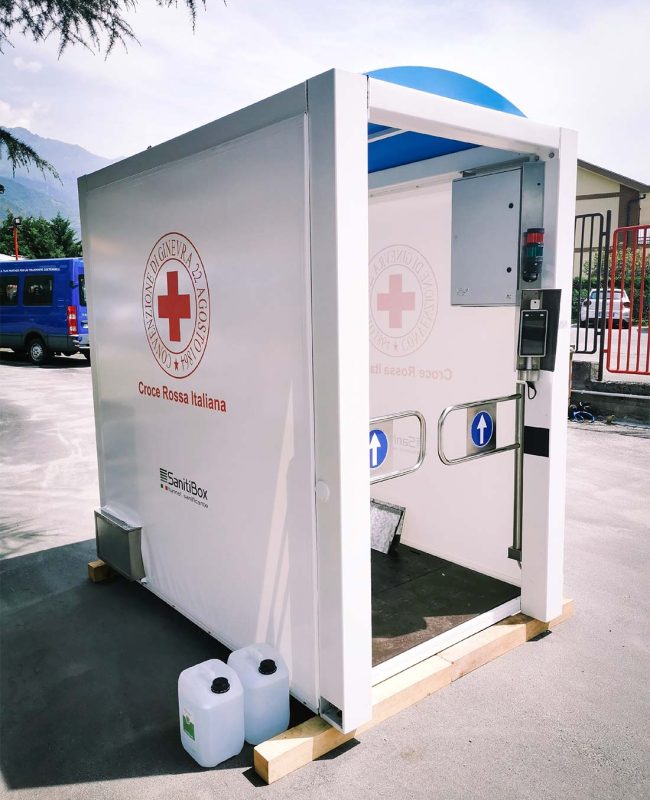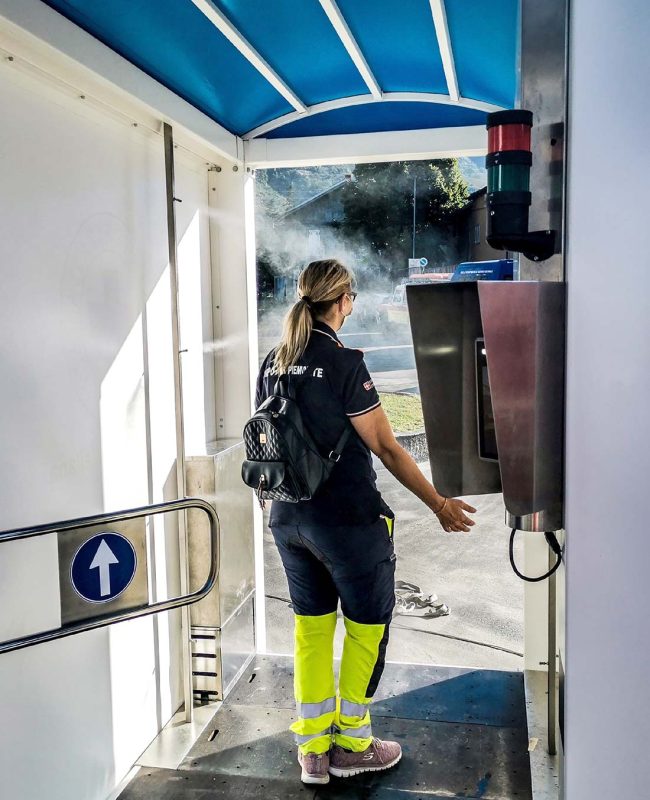SanitiBox
Freestanding tunnel SanitiBox
Freestanding tunnel with automatic sanitizing and disinfection of clothing and surfaces before entering any building: supermarkets, schools, public offices, stores, companies, hotels.
HOT-DIP GALVANIZED STEEL STRUCTURE
SANITIZING NEBULIZER SYSTEM
MOVEMENT SENSOR FOR TOUCHLESS ACTIVATION
INTEGRATED HIGH PRESSURE CIRCUIT IN ROOF
ROOFING FABRIC AND SIDE WALLS IN FIRE-RESISTANT PVC

SanitiBox with sanitizing system is designed to allow one person at a time, with regulated access. Easy installation and minimal bulk make this a pleasant addition to the facade of any building, historic or modern, and the ideal solution for the sanitization of people and goods.
Colors available
Sanitizing occurs as people pass through the tunnel, but also for carts carrying goods and other items. Sanitibox with sanitizing system features a nebulizer device. A movement sensor detects the presence of people or goods and special nozzles deliver a vapor of sanitizing liquid, which is stored in a reservoir in the lower side section of the tunnel. Optional extras include a reservoir on a trolley, which can be used with a dedicated spray nozzle to disinfect indoor spaces. The wheeled reservoir with sanitizer liquid can be taken into venues, and the spray nozzle can also used to sanitize workplaces.

The system is ready for connection to medium-tension 230 V outputs. It is supplied complete with a control panel in an IP56 cabinet containing, among other items:
- Single-phase protection for 230 VAC electric valve;
- Protection for SELV 24VDC power supply;
- SELV 24VDC power supply with built-in secondary protection (safety for cabling within reach).
The three versions available in the SanitiBox brochure – 1, 2 and 3 – do not require connection to the water supply, as they include one or two reservoirs with adjustable capacity. This means the appliance is independent of the water supply and does not require installation or the addition of bulky, unattractive bypass circuits. The sanitizing/disinfectant solution is placed in the built-in reservoirs. Refill frequency depends on the size of the reservoirs and the number of people entering. The system signals the need to top up the liquid when it detects low levels.
Measurements are engineered so that the appliance can be transported pre-assembled. The corners feature plates which allow lifting by crane. Dimensions and weight also allow transport using a small forklift. The new version of the brochure includes a supplementary charge of 200 euros for pre-assembly of the version with integrated floor and 150 euros for the version without.
SanitiBox 1 and SanitiBox 2 have a reservoir of approximately 50 liters, with the option of adding a further reservoir containing another 50 liters. SanitiBox 3 contains two 50-liter reservoirs, one linked to the nebulizer circuit for trolleys and the other to the nebulizer for people, with the option to add further reservoirs, for a total of four (two + two).
An optional version is also available with a trolley that can carry the reservoir/pumping system, allowing this to become a mobile device for sanitizing rooms. The system is engineered to optimize the use of sanitizing liquid. The distance between nozzles, type of nozzle, pressure used and electronic operating system are designed to prevent waste solution, while ensuring effective treatment.
Estimated consumption depends on the following variables:
- Number of applications or entries
- Type of delivery: people or objects
- Timing of the nebulizer, which is also adjustable for specific usage requirements.
To give an idea, the following examples are calculated based on use at a retail food store:
- SYSTEM: SANITIBOX 2
TIME PER PERSON: 5 seconds - TIME PER CART: 20 seconds
- ENTRIES (PEOPLE): 600 =>theoretical consumption 15 liters
- ENTRIES (CARTS): 400 =>theoretical consumption 50 liters
The system can be used with a range of sanitizing products, disinfectants, bactericides and virucides on the market, at the user’s discretion and in line with application limits established by the manufacturer of the substance and the appliance’s user manual. It is advisable to study the safety information relating to the product and check its suitability for specific uses against the user manual of the appliance.
Regarding recommended products, in general terms the Ministry of Health regulations at www.salute.gov.it recommend solutions of sodium hypochlorite in concentrations of approximately 0.1%. Also according to ministerial advice, “The percentage of active chloride that can eliminate the virus without causing irritation to the respiratory system is 0.1% for most surfaces”.
We have identified a commercial product in an aqueous solution electrolyzed at 58,000 volts which, during its formation process, develops 1.3 g of sodium hypochlorite per 1000 g, i.e. 0.13%. The manufacturer states, and accredited certification bodies confirm, that the electrolytic load obtained at high voltages makes the solution extremely effective, despite the very low concentration of the active principle. We have obtained confirmation from the manufacturer that the solution can be nebulized over people using nozzles of 10 to 15 microns, the size used by the SanitiBox system. Other alternative solutions are under consideration by our quality office.
For the sanitization of carts, sodium hypochlorite solutions can be used with concentrations exceeding 0. 13%.
The current setup is not suitable for users with disabilities. A SanitiBox 3.1 version is planned, with a width of 2.4 metres, suitable for wheelchairs.
A smaller-sized 1.1 version is under development, with a width of 150 cm and length 120 cm, designed for historic sites or special situations where access is restricted.
The SanitiBox 3 system brings together two separate nebulizer circuits, one for the person and the other for goods; these use different pumping systems and two independent reservoir units. This justifies the initial purchase cost, but becomes a determining factor in calculating running costs.
The logic of this proposal is that it allows the use of two sanitizing solutions, differing either by active ingredient or by concentration, and therefore by cost per refill.
In this sense, for nebulizing over goods, where the safety limits for humans are not applicable, highly effective but low-cost solutions could be used, providing they are safe for humans in the event of contact.
For example, several liters of solution could be prepared at minimal cost simply by mixing water and concentrated sodium hypochlorite.
- 0.038 per 10 micron/min
- 0.046 per 15 micron/min



